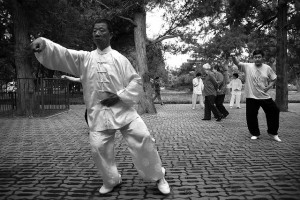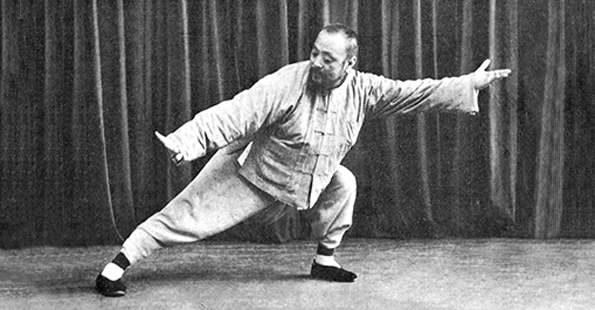This text reminds us of important points in the Classics, such as in the Mental Elucidation of the 13 Basic Movements:
If the life force can be lifted,
one is free from worries about heaviness or clumsiness.
This is also called: Suspending the head-top. […]
The spirit is still and the body is quiet,
always keep this in the heart/mind (xin).
(Taijiquan-Lilun Journal 4, p. 4)

Thus the written tradition of Taijiquan follows Daoist concepts, but direct quotations of whole sentences can be found in the Classics more in relation to Confucianism. This is not surprising when you consider that we only know about a few Taijiquan masters that they were Daoist hermits. More masters are found in the ruling elite of the country. This also means that they often completed a career as a Confucian official. In China it is said that such people had the ideal to be Confucians in their career and to be Daoist in their leisure time. The writer Lin Yutang called this ideal the “half-and-half-belief.” He commented that this “half and half” is “… lying somewhere between action and inaction, between being led by the nose into a world of futile busy-ness and complete flight from a live of responsibilities, and that so far as we can discover with the help of all the philosophies of the world, this is the sanest and happiest ideal for man’s live on earth. What is still more important, the mixture of these two different outlooks makes a harmonious personality possible, that harmonious personality which is the acknowledge aim of all culture and education. And significantly, out of this harmonious personality, we see a joy and love of life.” (Lin, p. 114)
One of the key concepts of Confucianism is the love for learning. It is defined as a desire fulfilled only by an enduring process. As it is stated in the book Confucius:
To learn
and to repeat from time to time
what has been learned,
is this not a pleasure?”
(Confucius 1, 1, Boedicker, p. 10)
Taijiquan has without doubt absorbed this bequest. Is it not said in the Song of the 13 Basic Movements:
The passing on of basic knowledge
and the guidance to the way
need to happen orally.
Ceaseless practice (gongfu)
is the method of self-cultivation.
(Taijiquan-Lilun Journal 2, p. 7)
But not only abstract concepts of Confucianism are found in the Classics. Even Confucian technical terms such as the inner nature xing, including an embedded quote from the book Confucius can be found. Confucius:
By nature we are close to each other,
by habits, we are moving away from each other.
(Confucius 17, 2)
In the classic Our Natural Power of Discrimination:
After we are born, the eyes can see,
the ears can hear, the nose can smell and the mouth can eat.
Colours, sounds, smells and tastes,
these five belong to the innate sensory endowment.
The movements of hands and feet and the skills of the four limbs
belong to the innate endowment of the natural movement.
Even if you consider this,
is it not that by nature we are close to each other,
but by habits we are moving away from each other?
(Taijiquan-Lilun Journal 5, p . 6)
Of particular importance in the Classics is the Neoconfucian philosophy of the Song period (960 – 1279 AD). It gave Taijiquan its cosmology. The first Neoconfucian Zhou Dunyi said:
Wuji and then taiji.
In movement taiji creates yang.
When the movement has reached its limit there is stillness.
When still, taiji creates yin.
When stillness has reached its limits, there is a return to movement.
Movement and stillness alternate.
Each is the root of the other.
(Taijiquan-Lilun Journal 1, p. 12)
In the Taijiquan Classic it is stated:
Taiji is born out of wuji.
It is the origin of movement and stillness
and the mother of yin and yang.
In movement, it separates;
in stillness, it unites.
(Taijiquan-Lilun Journal 2, p. 8)
Thus, in the Classics Confucian influence is significantly visible. But what about Buddhism? That Buddhism was not entirely without influence on the development of Taijiquan can been seen e.g. in a name of the Chen-Style Taijiquan form: “Buddha’s warrior pounds mortar”. Otherwise, in martial arts Buddhism, represented by Shaolin Kungfu, is rather considered as a counterpart to Taijiquan. After all Taijiquan tried to get a unique position in the world of martial arts. As it said in the Taijiquan Classic:
There are many different kinds of martial arts schools.
The movements might differ,
but in general the following is shared:
The strong oppressing the weak,
slowness resigning in the light of fastness.
The one with power defeats the one without.
The slow hand surrenders to the fast hand.
All of these are indeed inherent natural abilities,
which are not associated with study and practice.
The sentence ‘With the use of four ounces
one can easily deflect a thousand pounds’,
shows that one should win without the use of force.
Behold, an old man beats away several enemies.
How can this be by fastness?’
(Taijiquan-Lilun Journal 2, p. 8)
Also, there was extensive exchange between the masters of Taijiquan and other martial arts schools. It is known from many Taijiquan masters to have learned other martial arts. Thus Taijiquan developed always in competition and in exchange with other martial arts.

Leave a Reply